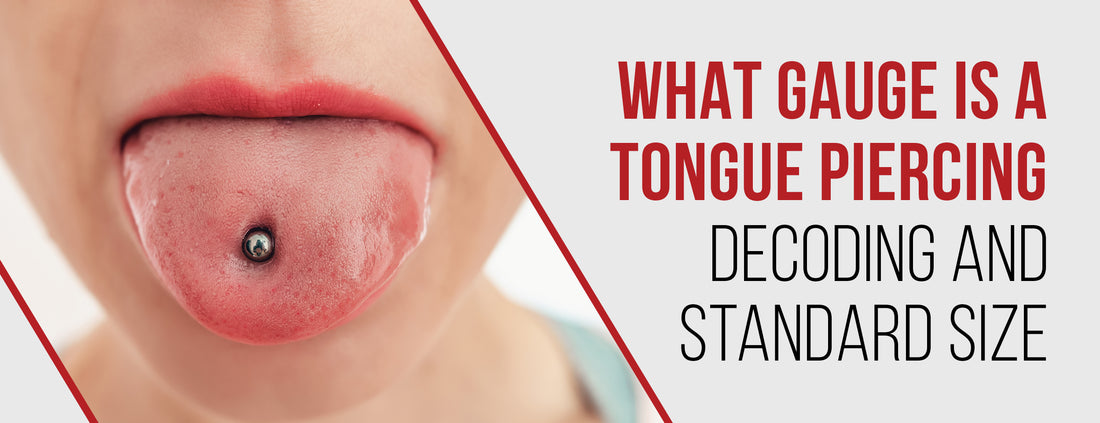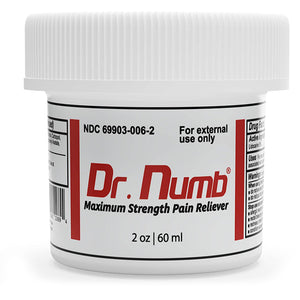A midline piercing is a classic tongue piercing that involves clamping the tongue and using a 14 gauge needle to pierce it halfway between the tip and the frenulum linguae (tongue tie).
Most tongue piercings use a 14 gauge (14G) gold or titanium barbell measuring 7/8 inches. You can shorten the barbell once the piercing heals. It's the same size as an initial tongue piercing.
We will discuss what gauge size is appropriate for a tongue piercing. We will also discuss choosing the perfect size, how to measure for a perfectly fitting tongue ring and aftercare tips.
What Gauge Is A Tongue Piercing: Decoding Size

In the realm of tongue piercings, understanding gauge size is paramount for a safe and comfortable experience. Let's delve into the basics to demystify this crucial aspect.
Defining Gauge Size in Body Jewelry
The gauge is the thickness or diameter of body jewelry. Your tongue piercing's fit, comfort, and success are all determined by it. Fit, comfort, and overall success of your tongue piercing.
- Gauge Numerals: Gauge sizes are numerically represented, with a lower number indicating a thicker diameter. For example, a 14-gauge is more accurate than a 16-gauge.
- Standard Sizing: The standard gauge size for tongue piercings usually falls within the range of 14 to 16 gauge. This ensures a balance between durability and comfort.
How to Measure Gauge Size?
Accurate measurement is critical to selecting the right gauge size for your tongue piercing. Here's a simple guide on how to measure it effectively:
- Use a Caliper: A caliper is a precise tool for measuring thickness. Gently place it around the jewelry, ensuring an accurate reading.
- Consult a Professional: Seek the assistance of a professional piercer. They have the expertise to provide precise measurements, ensuring a perfect fit.
The Importance of Choosing the Right Gauge Size
Selecting the appropriate gauge size is not just about aesthetics; it profoundly influences your piercing experience. Consider these factors:
- Comfort: A well-fitted gauge size enhances comfort, reducing the risk of irritation and discomfort during healing.
- Healing Time: The right gauge size promotes optimal healing, preventing complications and minimizing the overall healing time for your tongue piercing.

Common Materials Used for Tongue Piercing Jewelry
Equally important is the material of the jewelry. Tongue-piercing jewelry comes in various materials, each with its unique characteristics:
- Surgical Stainless Steel: Surgical stainless steel is a popular choice due to its durability and corrosion resistance.
- Titanium: Hypoallergenic and lightweight, titanium is an excellent option for those with metal sensitivities.
- Bioplast: A flexible and biocompatible material, bioplast reduces the risk of gum and tooth damage.
Tongue Piercing Gauge: Standard Size
If you are considering getting a tongue piercing, you might wonder about the standard gauge size for this type of piercing. We will discuss the size of a typical tongue piercing and the benefits and drawbacks of using a 14 gauge size. We will also provide information on adjusting the size after the healing period.
How Can the Size Be Adjusted After Healing?
After the initial healing period of six to eight weeks, your tongue piercing may feel comfortable, and you may want to change the jewelry. In this case, it's essential to do so gradually and with the guidance of a professional piercer to avoid damaging your piercing. Here are some tips on how to adjust the size of your tongue-piercing jewelry:
- Choose a slightly larger size: Start by choosing a slightly larger diameter for your new jewelry. Increasing the length by no more than 1mm at a time is recommended.
- Check for irritation: After changing the jewelry, check for any irritation or discomfort. Always make sure that you have adequately cleaned and sterilized the jewelry beforehand.
- Be patient: It may take some time to adjust to a new size, so be patient and give your tongue time to adapt.
The Benefits and Drawbacks of 14-Gauge
Using a 14 gauge size for a tongue piercing has both benefits and drawbacks that you should be aware of:
Benefits
- Widely Available: Since 14 gauge is the most common size for tongue piercings, finding jewelry in this size should be relatively easy.
- Less Likely to Cause Damage: Compared to larger gauge sizes, a 14 gauge piercing jewelry is less likely to cause damage to the tongue tissue that can lead to pain or complications such as speech impediments.
Drawbacks
- Not Suitable for Everyone: If you have a thicker tongue, there may be better options than a 14 gauge size. Also, you might need a larger gauge size if you want a more prominent piercing.
- Limited Jewelry Options: Since 14 gauge is a reasonably small size, there may be limited options for choosing jewelry for your tongue piercing.
Tongue Piercing Gauge: Other Sizes

For those considering getting a tongue piercing, it is essential to understand the different gauge sizes available and how they can impact the healing time and overall appearance of the piercing. Here is a breakdown of how different gauge sizes can affect the healing time and appearance of a tongue piercing.
Healing Time:
Larger gauge sizes take longer to heal, creating a more significant wound than smaller gauge sizes. Here is how different gauge sizes impact healing time:
- 14 Gauge: Typically takes 4-6 weeks to heal.
- 12 Gauge: It takes longer to heal, around 6-8 weeks.
- 16 Gauge: May heal quicker than 14 gauge since it creates a more minor wound, around 2-4 weeks.
Healing times can differ from person to person and depend on how well the piercing is cared for during the healing process.
Appearance
Gauge size can also impact the appearance of a tongue piercing. Here are some factors to consider:
- Larger gauge sizes can create a bolder, more noticeable look than smaller ones.
- Smaller gauge sizes can appear more delicate and understated.
- The type of jewelry used can also impact the overall appearance of the piercing, regardless of gauge size.

Pros and Cons
Different gauge sizes come with their pros and cons. Here are some things to consider when deciding on a tongue-piercing gauge:
- Larger gauge sizes can accommodate larger jewelry and create a bolder look.
- Smaller gauge sizes are easier to care for during the healing process.
- Larger gauge sizes may limit the types of jewelry that can be worn since not all jewelry is available in all gauge sizes.
- A smaller gauge size may not provide the bold look some people want.
Conclusion
Tongue piercings have become increasingly popular over the years, and it's crucial to make an informed decision about gauge size before diving into the trend. The gauge size describes the thickness of the jewelry used in piercings, making it a critical factor to consider.
While 14 gauge is generally the standard size for a tongue piercing, varying sizes can cause different effects, leading to a positive or negative piercing healing experience.
Always measure the tongue for a perfect fitting tongue ring, choose a suitable material, like surgical steel, for quality, and seek professional advice on caring for your piercing. Knowing the correct gauge size and care tips will ensure a successful and enjoyable tongue-piercing experience.










![The Recovery Time and Stages of Nipple Piercings [Best Practices]](http://drnumb.com/cdn/shop/articles/How_Long_Do_Nipple_Piercings_Take_To_Heal__3_Stages_Explained.jpg?v=1714373243)

